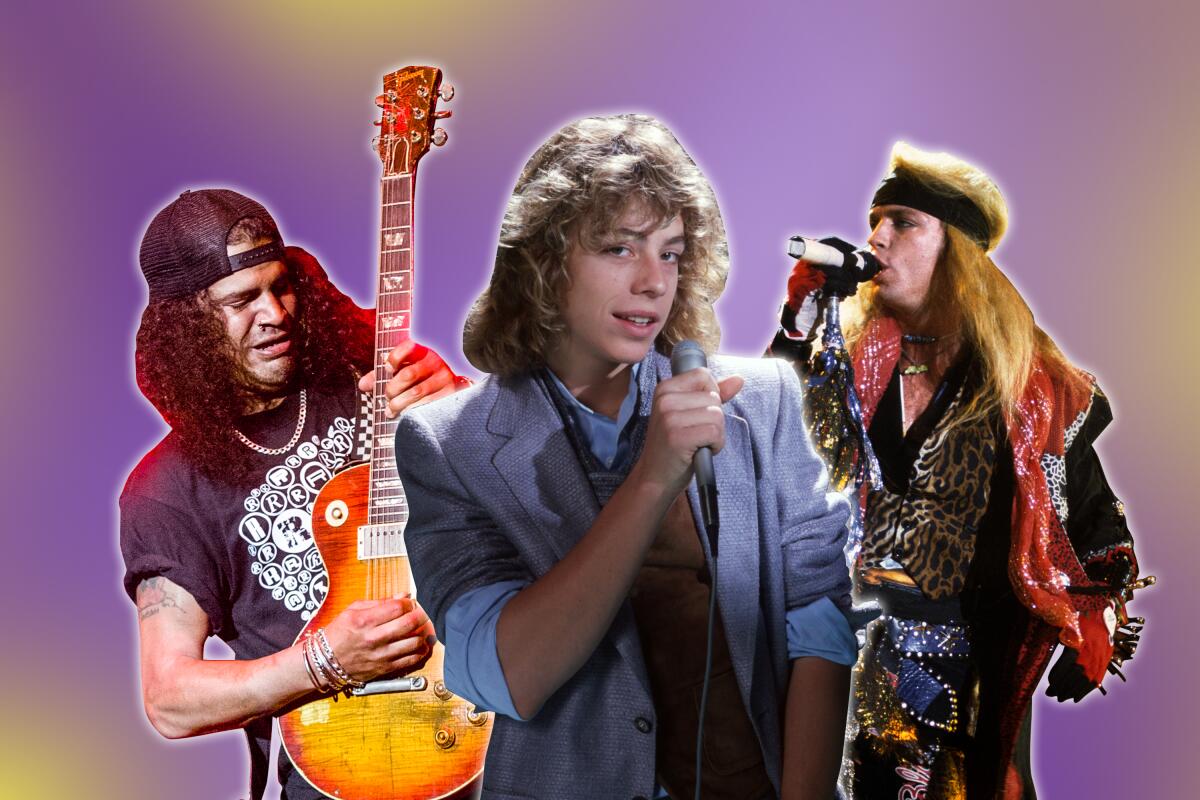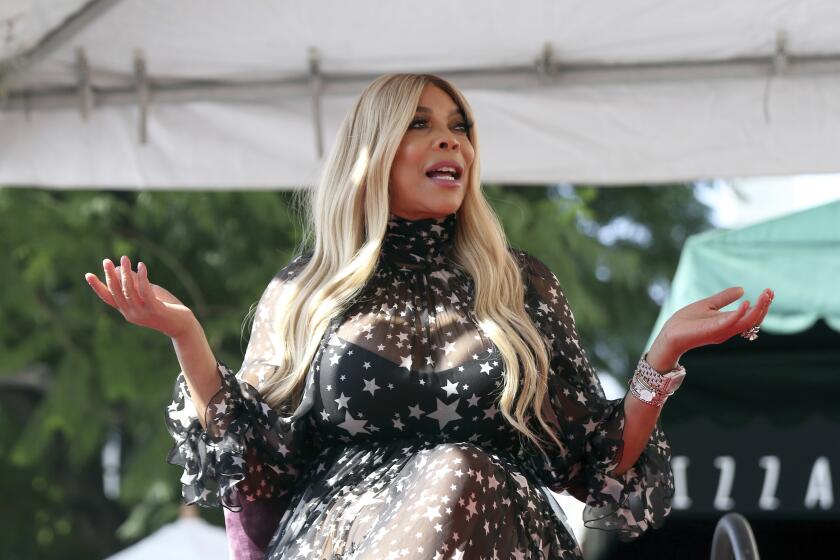‘Open with a funeral, end with a gunshot’: Inside the original ‘Behind the Music’

- Share via
When Bret Michaels and members of “Rock of Love’s” Season 2 cast traded sweet nothings about their experiences on VH1’s popular reality series for the taping of a post-season postmortem, I’m certain the word “awesome” was uttered more than once. But the details are fuzzy. This was 2009, after all, and I had bigger things to worry about: I was producing Michaels’ episode of “Behind the Music,” and the 16-week production cycle was winding down. I needed one more follow-up with the subject to fill holes and lock the script.
In many ways, Michaels’ story fit into “Behind the Music’s” hard-rock-sex-drugs-party-success-crash-burn-sex-tape-and-redemption template. Except, at the time, “Rock of Love” was VH1’s most valuable franchise. It was clear but unspoken that this episode was to be promotional puffery in advance of “Rock of Love’s” third season. My mission: Document the bandana-wearing reality star’s “quest for true love.” It didn’t quite hit with the same impact as Mötley Crüe bassist Nikki Sixx flatlining after a narcotic misadventure, but you work with what you’ve got.
For the record:
2:07 p.m. July 28, 2021An earlier version of this story misstated the date of the Bret Michaels episode of “Behind the Music.” It is Aug. 26, not Sept. 2.
Although Michaels was no longer a rock star, he was excellent at playing one on TV; he projected earnestness, as shiny and polished as an old stone flushed through a rock tumbler. Poison, for which Michaels was the frontman, had been the subject of its own “BTM” a decade earlier, and Michaels could spin his life’s dramas in his sleep. This time, though, I was starting to feel a bit like teenage journalist William Miller in “Almost Famous,” touring the U.S while futilely trying to pin down rock god Russell Hammond. I’d chased Michaels across the country — first in L.A., then to the House of Blues in Atlantic City and back. This was my last chance.
For “Behind the Music” though, fresh chances are part of the lore. After the short-lived spinoff “BTM 2” about emerging artists and the follow-up series “Behind the Music: Remastered,” the franchise is back — again — streaming eight new installments on Paramount+, with mostly familiar faces (including Michaels on Aug. 26). Only Fat Joe hasn’t been profiled before. A double feature of Ricky Martin and LL Cool J kicks off the reboot Thursday.
Commentary * Do we like these biographies because they, like, stoke our rock ‘n’ roll fantasies?
The series’ heyday came more than two decades ago, in the late ’90s when modem connection speeds were slow and social media existed primarily in AOL chat rooms. Information about our favorite rock stars was harder to come by, and those stars were less accessible to fans, their appearances and interviews carefully controlled by record labels and management. “Behind the Music” succeeded — earning Emmy nominations and parodies on “The Simpsons” and “Saturday Night Live” — because it offered rare and sometimes revealing glimpses behind the curtain.
“We caught lightning in a bottle,” said the series’ former executive producer, Paul Gallagher. “We just happened to be the people who said, ‘Hey, could you just explain that to me? How does it make sense that you ended up in this position?’ Nobody had ever given them the chance to tell that story.” The exposure was beneficial to participants, increasing their profiles, promoting tours and juicing album sales at a time when those things still mattered.
Success certainly wasn’t guaranteed, though. When “Behind the Music” debuted in August 1997 with an episode on Milli Vanilli, VH1 was a struggling cable channel just trying to hang on. The more adult-oriented sister network of MTV, on the verge of being dropped by several major U.S. cable carriers, needed a hit. With little to lose, network President Jeff Gaspin asked producers Gay Rosenthal and George Moll to create a music biography show in the style of a recent VH1 News special about heroin use in rock ’n’ roll called “Dying in Vein,” on which both Gallagher and Moll had worked.
“[Gaspin] threw the keys to Gay Rosenthal and myself to create the franchise. We never audience tested. As a matter of fact, I don’t know if we showed rough cuts to anyone, really. We just went to air with it,” Moll says. “It turned the fortunes of the channel completely.”
“Behind the Music” was flashy — in its tricked-out editing, heavy-handed scripting and incessant probing of rock’s dark side, be it the excesses of bands like Mötley Crüe and Poison, the incestuous relationships in Fleetwood Mac and the Mamas & the Papas or Badfinger’s brutal, tragic story. The most resonant episodes were larger than life.
“First and foremost, the mission of that show is to be entertaining,” says Moll. “So much of rock ’n’ roll storytelling was done with such reverence. If it isn’t fun, it isn’t rock ’n’ roll, in my view.”
But one of “Behind the Music’s” most poignant moments came with the volume turned low. While doing research for a Leif Garrett episode in 1999, Gallagher learned that the former teen idol had been behind the wheel during an auto accident in 1979 that left his passenger, Roland Winkler, paralyzed. “They had been very, very good friends,” Gallagher remembers. “And Roland didn’t have any animosity at all. He was like, ‘We were young and drunk and stupid.’ At that point, if I can get the two of them together to meet, it would be compelling.”
Gallagher arranged a filmed reunion at Los Angeles’ Griffith Park that was uncomfortable, intense and heartbreaking, as Winkler revealed to his old friend just how the car accident had changed his life.
VH1’s reality: A rock and a hard place
I produced six “Behind the Music” episodes from 2004 to 2011. The series’ golden age had ended, a victim of network overkill (incessant re-airings, marathon programming) and a changing culture. Still, there was a lot to measure up to.
The directive, at least initially, was the same. Moll’s mantra — “Open with a funeral, end with a gunshot” — was never far from my mind. Luckily, I had great source material: My first three episodes were Guns N’ Roses, Ratt and Pantera. I was able to incorporate every hot-button theme in the “Behind the Music” playbook: sex, drugs, band infighting, debauchery, superhuman addictions, personal tragedy, death, near-death and redemption.
It wasn’t easy. Scripting the ferocious dumbness of the trademark voice-over copy was truly an art form. I had one self-imposed scripting rule: Include the word “incendiary” in every episode.
“I think we just really wanted to blow it up, to make all the stories bigger than life,” Moll says. “At times, it may have been slightly absurd, but it was memorable.”

An episode’s mood-setter was the cold open. And bigger was always better when focusing on the hard rock genre. Here’s a sampler of some of my greatest hits:
Ratt: “They grabbed a decade of decadence by the tail and gnawed their way into hair band history.”
Pantera: “They were cowboys from hell who lassoed the metal world by the throat.”
Guns N’ Roses: “Their hunger for success was matched only by their appetite for excess.”
It was ridiculously over the top on the page but always sounded perfectly reasonable when narrated by Jim Forbes, who has been the cool and calm voice of the show (save two episodes) since its inception.
The Guns N’ Roses episode was complicated by the noncooperation of vocalist Axl Rose, who at the time was feuding with his original bandmates. Instead, it was anchored by a long interview with Slash, conducted by the show’s co-producer, who did great work while matching the guitarist Guinness for Guinness. There were other highlights: Tour manager John Reese described the time he found Slash seemingly dead and blue in front of an elevator after a heroin overdose before being revived. And drummer Steven Adler opened up about the addictions that got him tossed from the band — the day after he hosted our crew for a night of drinking in Las Vegas that included a member of our traveling party spilling red wine on his white carpet, then casually moving a chair over the stain.
Guns’ strong catalog made it easy to ruminate a bit about the music. Ratt was a bit trickier. “Round and Round” had been its only mainstream hit — and that song was probably best known for the appearance of Milton Berle in drag in the music video. Thus the focus was less on the music and more on everything that engulfed the music. I took cues from a never-aired 1999 interview with former Ratt guitarist Robbin Crosby, who’d contracted HIV from his IV drug use, pretty much lost everything and died of a heroin overdose three years after the interview. His remarks became a crucial roadmap for my approach to the band’s story.
The Times TV team discusses watching an often deflating, thoroughly chaotic Olympics — and why NBC’s approach to televising it is part of the problem.
The band members’ eyes widened when recounting their excesses and conquests of two decades earlier. One of their cherished memories was of a tour bus filled with bras, panties and sex toys hanging from the ceiling. It was classic “Behind the Music”: All that was missing was the needle drop to “Smells Like Teen Spirit” to signal the downfall of their career.
Guitarist Warren DeMartini, however, was not amused. After the episode ran, he told a website called Heavy Metal Examiner: “They wanted to focus on stuff that I would not consider appropriate for a documentary — because documentaries are not supposed to be biased.”
The definition of bias notwithstanding, I’m not sure audiences were tuning in for a lyric discourse on “Lovin’ You Is a Dirty Job.” After all, the show was called “Behind the Music,” not “The Music.”
Pantera vocalist Philip Anselmo was also not pleased by his “BTM” portrayal. His problems with heroin hastened the breakup of the band (he was also declared legally dead at one point), and shortly after the split he told Metal Hammer magazine that guitarist “Dimebag” Darrell Abbott “deserves to be beaten severely.” This amped up the acrimony among him, Abbott and his brother, Pantera drummer Vinnie Paul Abbott.

In 2004, less than a year after Anselmo’s remarks, “Dimebag” Abbott was killed while performing onstage with his new band, Damageplan, at a club in Columbus, Ohio.
The emotions were raw, and Abbott family members weren’t letting Anselmo off the hook for his remarks, which they believed may have provoked the killer.
Anselmo wasn’t letting “Behind the Music” off the hook, either. He agreed to participate in “Behind the Music Remastered” and vented about the 2006 original. “Sorry for your f— up ... asinine program that smeared my name to the goddamn toilets of every house in America,” he said. “You motherf— didn’t have to live with it. I did. I resent it — still resent it.”
Detailing Abbott’s slaying was difficult, particularly because so much of the Abbott brothers’ story was a joyous rock ’n’ roll dream. As Pantera evolved from a standard-issue hair metal band to heavy groove metal pioneers, its members basked in the rock lifestyle. I was even able to glimpse the accoutrements of their fame: Before interviewing Vinnie Paul Abbott, I met him at his Dallas strip club, the Clubhouse. At his home, I was shown the pool, shaped like a Crown Royal bottle, in his backyard, an homage to the band’s cocktail of choice — the Black Tooth Grin (equal parts Seagram’s 7 and Crown Royal, with a splash of Coca-Cola).
Oh, and after many hours of waiting, I did get that final interview with Michaels. As a sort of apology, his rep said with a wink that Michaels might have been delayed because of some quality time he’d spent with a “Rock of Love” cast member in his trailer. It was very on-brand of her to say, but I’m not sure I believed it.
Can the new episodes of “Behind the Music” top the original? Will they even try, especially now, when artists freely share their lives on social media?
“There are no stories that haven’t been told,” Moll says. “How much is there to be revealed?”
Well, if they start with a funeral and end with a gunshot, there’s always a chance.
‘Behind the Music’
Where: Paramount+
When: Any time, starting Thursday
Rating: TV-MA (may be unsuitable for children under the age of 17 with an advisory for coarse language)
More to Read
The complete guide to home viewing
Get Screen Gab for everything about the TV shows and streaming movies everyone’s talking about.
You may occasionally receive promotional content from the Los Angeles Times.








